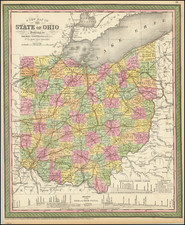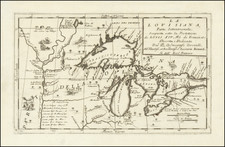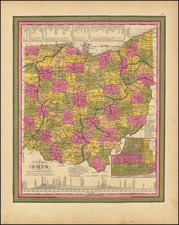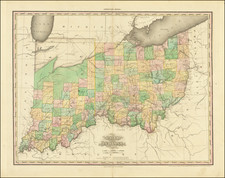Important Eighteenth-Century Manuscript Map of the Indian Earthworks at Marietta, with Intriguing Ties to Spain and the Settlement of the Old Northwest
Remarkable late 1780s manuscript map of the monumental remains left by the mound-building Hopewell culture at the future site of Marietta, Ohio—the first American settlement north and west of the Ohio River. Signed by Winthrop Sargent and produced for presentation to Don Diego Gardoqui, Spanish Minister to the United States, the map hints at Spain’s schemes regarding the American frontier and a possible connection between that country and American speculators in Ohio lands.
This highly-finished manuscript map depicts the area at the intersection of the Ohio and Muskingum rivers in southeastern Ohio, the site of the present-day city of Marietta. Rendered almost entirely in Spanish, its principal subject is the vast complex of earthworks (“Indian mounds”) extending for more than a mile along a rise on the east bank of the Muskingum. These earthworks proved to be central to the development of United States archeology and are described in some detail by legends at the left and right of the map. As an Ohio map expert explains:
There is little doubt that the study of archaeology in the United States during the major part of the nineteenth century was concentrated around the antiquities located in the state of Ohio and in the Ohio Valley, and that it gave to American men of learning a topic for consideration that promoted American scholarship independently of European initiative (Smith, p. 33).
The map’s other notable feature is Fort Harmar, a pentagonal structure along the west bank of the Muskingum where it enters the Ohio. The Fort was constructed in 1785 by the United States government to prevent white squatters from entering the region and sparking conflict with native American peoples.
Winthrop Sargent in Ohio
The map bears the signature of Winthrop Sargent (1753-1820), though likely it and the map itself are in the hand of an anonymous draftsman. A native of Gloucester, Massachusetts, Sargent had served in the American Revolution as an artillery officer. Later, he worked under Thomas Hutchins in the Survey of the Seven Ranges, the first lands to be laid out for sale under the Land Ordinance of 1785. Exploiting his intimate knowledge of the region, he went on to form the Ohio Company of Associates and was an important shareholder in the Scioto Company.
In 1788 Congress appointed Sargent First Secretary of the Territory, the second-highest position in the territorial government, a role he held until 1798. In May of 1788, Sargent arrived at the Ohio Company settlement at Marietta, the first sanctioned American settlement beyond the Ohio River, which in July of that year had been named the territorial capital. He went on to serve as Governor of the Mississippi Territory from 1798 to 1801, when he was turned out of office by the incoming Republican administration. He then became a planter in Natchez, where he spent the reminder of his life. He was a founding member of the Society of the Cincinnati and an elected member of the American Philosophical Society.
Sargent, Don Diego de Gardoqui, and the map of the earthworks
While in Ohio—probably in late 1786 or early 1787—Sargent had visited the earthworks along the Muskingum, taken measurements, and, in March 1787, submitted an English-language map of the site to the American Academy of Arts and Sciences. That map and the Spanish-language one offered here are very closely related, even employing an identical alphabetical key to identify features of the landscape. Whether they are based on Sargent’s own surveys or on the work of another is unclear; they may have been based on one drawn by Captain John Heart, whose plan of the earthworks was published in the May 1787 issue of Columbian Magazine.
The map’s title includes a presentation inscription from Sargent to Diego de Gardoqui (1735-1798), the son of a wealthy Basque family in Bilbao, Spain. During the American Revolution Gardoqui acted on behalf of both his family firm and the Spanish government as an intermediary with the Continental Congress, helping to arrange the sale to the Americans of huge quantities of weapons and stores. After the Revolution he stayed on in America as Minister to the United States from 1785 to ca. 1788. In this capacity he negotiated with John Jay the Jay-Gardoqui Treaty, which would have ensured Spain 25 years of exclusive use of the Mississippi. However, the agreement was never ratified by Congress.
The map’s highly respectful inscription and the presence of Sargent’s signature suggest that the presentation of this map was very much a personal gesture. While the surviving historical record does not reveal a close relationship between the men, there is no doubt that they traveled in intersecting circles and were quite aware of each other. For example, a September 29, 1788 letter from one William Knox to Sargent, held in the Sargent Papers at the Massachusetts Historical Society, speaks of Gardoqui as someone with whom both Knox and Sargent were acquainted. Interestingly, both men were elected to the American Philosophical Society in the same year, 1789. Although intriguing--the unlikely pairing of the Yankee frontier surveyor and land developer with the cosmopolitan European diplomat--the map may reflect nothing more than an elaborate gesture of courtesy from one eighteenth-century gentleman scholar to another. However, it also shows the knowledge networks at work in early America.
A window on Spanish intrigue on the American frontier?
It is just possible, though, that the map shines a light on Spanish attempts to influence settlement on the Ohio frontier. Spain at this time held title to the vast Louisiana Territory west of the Mississippi, as well as navigation rights to the river itself. At the same time, the Treaty of Paris of 1783 recognized American territorial control of the east bank of the Mississippi, causing American settlers to flood westward. Spain’s dilemma was in how to maintain a position of strength in the areas it nominally held when in reality it did not have the resources to colonize or defend these lands in any substantial way.
Spain adopted a strategy of inducing American settlers to remove to Spanish-held territory west of the Mississippi and become loyal Spanish citizens in the hope that they would form a reliable barrier to American expansion. While offering a variety of inducements, perhaps the major carrot was navigation rights to the Mississippi River, which Spain had suspended for Americans from 1785 onward. Spain perhaps felt that it could lure a sufficient supply of Americans—some disgruntled with their own government and some former Loyalists—to provide the beginning of a population pool for its territories. Some of these efforts did come to fruition. Perhaps the best-known example is New Madrid, founded in 1788 by Kentuckian George Morgan on land granted by Gardoqui himself on the west side of the Mississippi River, opposite the mouth of the Ohio River.
The warmth of the map’s inscription raises the intriguing possibility that Sargent was in some manner in Gardoqui’s debt. It is conceivable that Sargent may have been in one way or another the beneficiary of the largesse dispensed by Gardoqui, in the latter’s efforts to forestall American westward expansion. This map, with its academically-tinged subject matter, was perhaps an innocuous way for Sargent to pay a debt to a patron without being seen to convey sensitive cartographic information.
In all, this is a fascinating manuscript map with links to the early years of American archaeology, the opening of the Northwest Territory to American settlement, and the culture of scientific exchange in the eighteenth century. At the same time, it suggests the intriguing possibility of Spanish attempts to influence settlement in the Ohio country.
Rarity
This example of the map is otherwise unknown to modern scholars.
Winthrop Sargent presented to the American Academy of Arts and Sciences in May of 1787 a small notebook which included a title page, presentation text, key sheet and single page much smaller English language version of the present map entitled Plan of the Ruins of an Ancient Town or fortified Camp near the Confluence of the Ohio and Muskingum Rivers presented to the American Academy of Arts and Sciences by their most obedient Winthrop Sargent, which survives in the collection of the of the Academy.














![(Cleveland Beer Drinkers) [Photograph of Zwiebel Brigade Drinking Beer in Cleveland]](https://storage.googleapis.com/raremaps/img/small/96294.jpg)

![[Carolinas, Virginia, the Chesapeake, Pennsylvania, New York]](https://storage.googleapis.com/raremaps/img/small/71479.jpg)